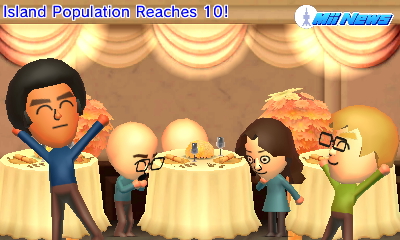If there is a reason that the hardcore Nintendo fans are so loyal, it’s because of “The Nintendo Difference”. It’s the company’s biggest X-factor, a stubborn desire to do things their own way, no matter whether it’s successful or not. Granted, Nintendo are known more for their reliance on long-running IPs, but every once in a while, something comes along that’s just… well, different. The kind of thing you can’t imagine anyone else attempting to do.
 Released in 2009 for the original Nintendo DS, Tomodachi Collection was one such game, a Japanese-only release that was a surreal hybrid of The Sims and Animal Crossing, where players could watch their Mii characters go about their daily lives. Originally deemed far too “Japanese” for a Western audience, Nintendo have brought over it’s 2013 sequel to Western shores, and it’s unlike anything else you’ve seen. It’s a game that manages to be incredibly engaging, despite asking for little interaction from the player.
Released in 2009 for the original Nintendo DS, Tomodachi Collection was one such game, a Japanese-only release that was a surreal hybrid of The Sims and Animal Crossing, where players could watch their Mii characters go about their daily lives. Originally deemed far too “Japanese” for a Western audience, Nintendo have brought over it’s 2013 sequel to Western shores, and it’s unlike anything else you’ve seen. It’s a game that manages to be incredibly engaging, despite asking for little interaction from the player.
But I’m a little ahead of myself here. The entirety of your Tomodachi Life is set on an island, which you name yourself. Your first inhabitant is supposed to represent yourself, in fact the other islanders refer to you as your Mii’s doppelganger. From then on, you are left to discover things mostly on your own, adding more Miis to your very own apartment block. Each day, you’re given monetary donations from each of the inhabitants of your island, so the more Miis you make, the more money you receive each day.
 This cash you receive goes towards keeping your Miis happy, which is essentially as close to a goal as Tomodachi Life gets. Each one will regularly have some sort of request or issue that needs your attention and assistance, from the basics of food and clothing to help with their social lives. Completion of these tasks will increase the happiness of your citizens, levelling them up and also giving you a little money back. Essentially, all the rewards you receive are put back into giving your Miis the best life possible.
This cash you receive goes towards keeping your Miis happy, which is essentially as close to a goal as Tomodachi Life gets. Each one will regularly have some sort of request or issue that needs your attention and assistance, from the basics of food and clothing to help with their social lives. Completion of these tasks will increase the happiness of your citizens, levelling them up and also giving you a little money back. Essentially, all the rewards you receive are put back into giving your Miis the best life possible.
Occasionally, your Miis challenge you to a game of some sort, such as card matching or guessing an item from a pixelated image or silhouette. Success in these short mini games results in receiving a treasure, which can be sold for more money. As you can imagine, more money means more expensive and luxurious goods.
 Other than a few other minor interactions and buying gifts (clothes, room decorations and food), most of your time is spent watching the people you’ve created interact with each other. You’re able to configure every part of their personality, from their voice to whether they’re caring or direct, unique or normal, and more. Each Mii is an individual and will act and socialise as such, making for some funny and surreal interactions. They’ll make friends, have arguments and even fall in love with each other, hopefully having children. You’ll see their dreams as they sleep, and even see them as the subject of regular news reports that are as hilarious as they are crazy. Every interaction paints a vivid picture of the lives of these virtual people, telling new stories each day that never fail to raise a smile. Each Mii’s unusual computerised voice continues to give them all a distinct sense of personality.
Other than a few other minor interactions and buying gifts (clothes, room decorations and food), most of your time is spent watching the people you’ve created interact with each other. You’re able to configure every part of their personality, from their voice to whether they’re caring or direct, unique or normal, and more. Each Mii is an individual and will act and socialise as such, making for some funny and surreal interactions. They’ll make friends, have arguments and even fall in love with each other, hopefully having children. You’ll see their dreams as they sleep, and even see them as the subject of regular news reports that are as hilarious as they are crazy. Every interaction paints a vivid picture of the lives of these virtual people, telling new stories each day that never fail to raise a smile. Each Mii’s unusual computerised voice continues to give them all a distinct sense of personality.
But eventually, there comes the realisation that this isn’t a game in the traditional sense, and that might put many people off. Much like the 90% of Animal Crossing players who lose interest in their towns after a few weeks, the same will no doubt be true of Tomodachi Life, as the constant compliance with the Mii’s requests may prove too repetitive for many. Despite the odd flash of the unusual, most of the time you will be performing the same tasks, buying clothes and food, with the occasional break for the same few minigames. It’s strange that, for a game that prides itself at being imaginative and unusual, the time when events and requests start repeating is far too early, sinking the actual gameplay element of Tomodachi Life into monotony.
 Still, it’s the unexpected events that are the payoff for the repetition, along with the constant sense of discovery as you see the results of plonking your Miis in different locations and giving them different items, just to see what they do with them. Much like Animal Crossing, there are events that you can partake in, depending on the real-world time, such as Rap Battles and a daily market. Then, there’s the concert hall where your Miis can perform the songs you teach them, based on genres they earn when levelling up in happiness.
Still, it’s the unexpected events that are the payoff for the repetition, along with the constant sense of discovery as you see the results of plonking your Miis in different locations and giving them different items, just to see what they do with them. Much like Animal Crossing, there are events that you can partake in, depending on the real-world time, such as Rap Battles and a daily market. Then, there’s the concert hall where your Miis can perform the songs you teach them, based on genres they earn when levelling up in happiness.
VERDICT: Ridiculous, hilarious and full of the unique surrealism that Nintendo does so damn well, it’s hard not to fall in love with Tomodachi Life and the characters you create. The sedate pace and minimal interaction might not be everyone’s cup of tea, but this is guaranteed to be a cult hit. Worth experiencing at least once to see something genuinely funny and unusual, this is the kind of game that reminds you how imaginative Nintendo can be.

VERY GOOD. An 8/10 is only awarded to a game we consider truly worthy of your hard-earned cash. This game is only held back by a smattering of minor or middling issues and comes highly recommended.
Review code provided by publisher.





